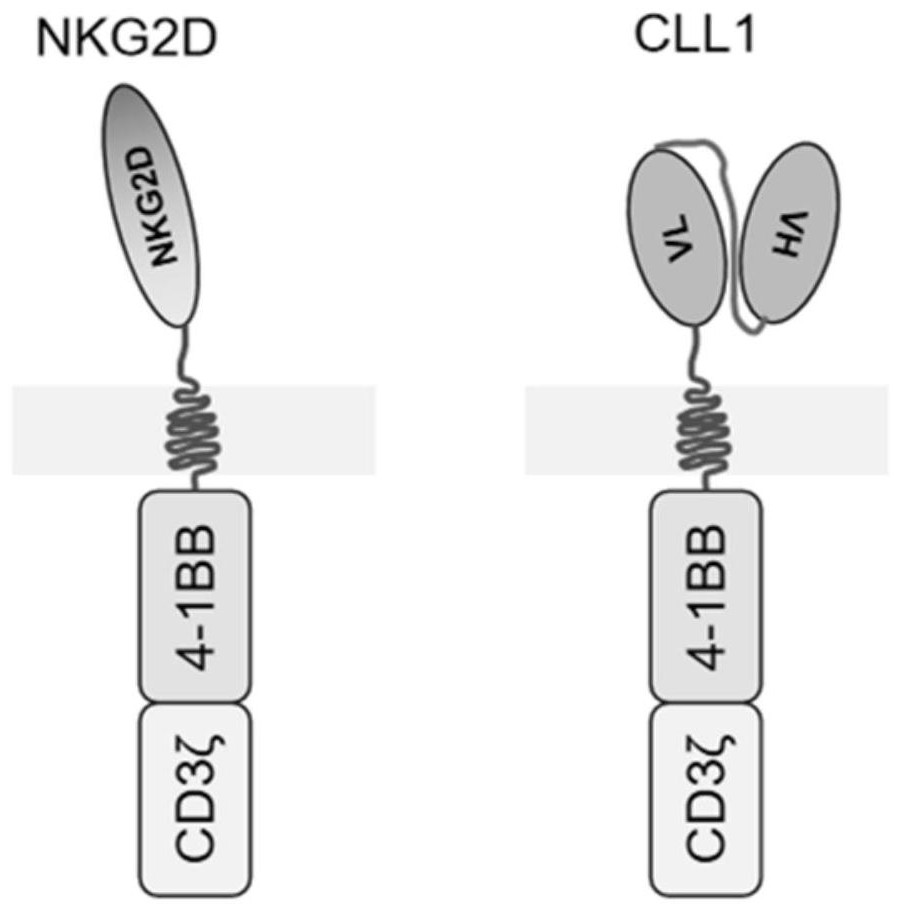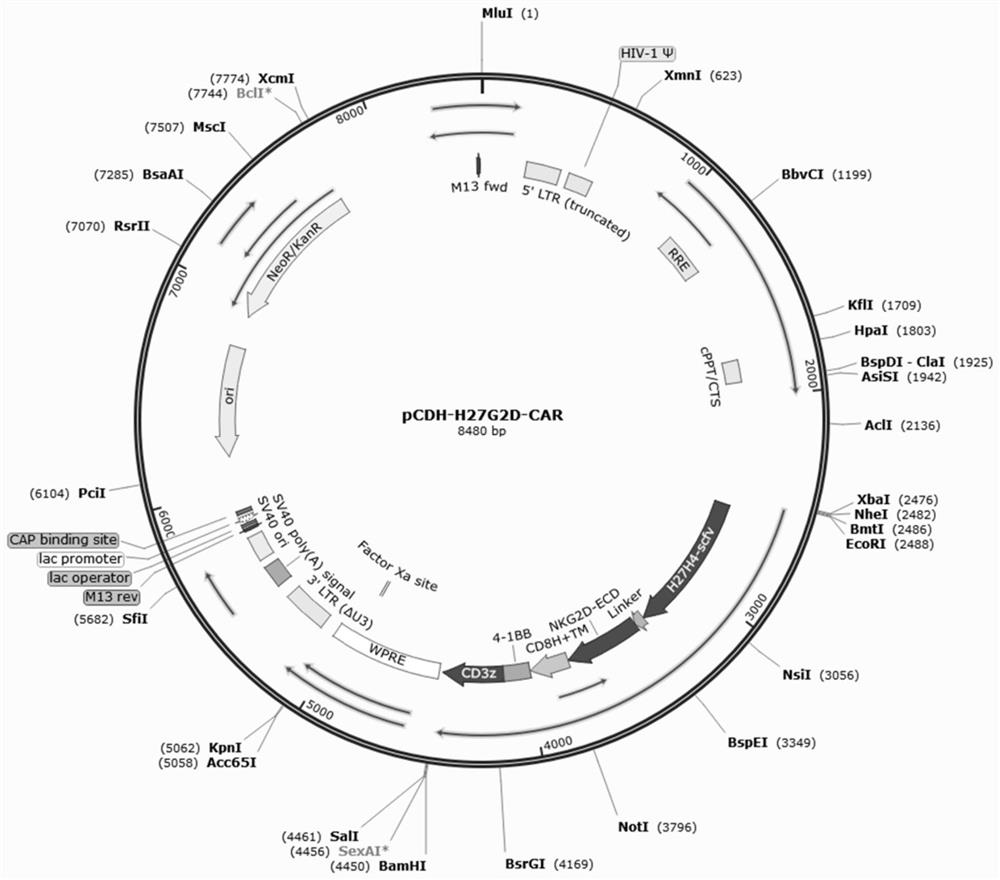Double-target chimeric antigen receptor targeting CLL1 and NKG2D ligands and application thereof
A chimeric antigen receptor and dual-target technology, applied in the field of biomedicine, can solve problems such as reducing the recurrence rate of the disease, and achieve the effects of reducing the probability of disease recurrence, solving the problem of tumor antigen heterogeneity, and achieving a significant killing effect.
- Summary
- Abstract
- Description
- Claims
- Application Information
AI Technical Summary
Problems solved by technology
Method used
Image
Examples
Embodiment 1
[0096] Example 1 Design of Chimeric Antigen Receptor
[0097] This example uses anti-CLL1 antibody H27H4 (SEQ ID NO: 1 ~ 2), 1075.7 (SEQ ID NO: 3 ~ 4) or 27H4 (SEQ ID NO: 5 ~ 6) and NKG2D extracellular segment (NKG2D-ECD, SEQ ID NO:7) as the antigen-binding domain, combined with CD8α signal peptide (SEQ ID NO:16~17) or IgGκ light chain signal peptide (SEQ ID NO:34~35), CD8α hinge region (SEQ ID NO:18~ 19) and transmembrane region (SEQ ID NO:20~21), 4-1BB co-stimulatory domain (SEQ ID NO:22~23) and CD3ζ signaling domain (SEQ ID NO:24~25), construct target The dual-target CAR (SEQ ID NO: 8-13) to CLL1 and NKG2D ligand (NKG2DL), the structural diagram is as follows Figure 1A shown;
[0098] This example also constructed an anti-CLL1 single-target CAR (SEQ ID NO: 26-27, SEQ ID NO: 28-29, SEQ ID NO: 30-31) and an anti-NKG2DL single-target CAR (SEQ ID NO: 32- 33), the structural diagram is as follows Figure 1B shown.
[0099] The relevant information of CAR molecules is shown ...
Embodiment 2
[0102] Example 2 Construction of Chimeric Antigen Receptor Expression Vector
[0103] (1) According to the CAR molecule designed in Example 1, the codon of the CAR coding gene was optimized to promote its high expression in human cells, and the CAR coding gene was synthesized from the whole gene (Guangzhou Aiji Biotechnology Co., Ltd.);
[0104] (2) The full-length CAR gene and the empty vector pCDH-EF1-MCS were digested with EcoRI and BamHI, digested in a water bath at 37°C for 30 min, and then subjected to DNA electrophoresis using 1.5% agarose gel, and purified using agarose gel The recovery kit (Tiangen) purifies and recovers the digested product;
[0105] (3) Prepare the ligation system shown in Table 2, ligate the CAR gene fragment and linearized pCDH-EF1-MCS at 22°C for 1 h, transform the ligated product directly into Stbl3 E. coli competent cells, take 200 μL of the transformed product and coat it with ampicillin LB plates were cultured upside down in a 37°C incubator...
Embodiment 3
[0109] Example 3 lentiviral packaging
[0110] In this example, the four-plasmid system is used to package the lentiviral expression vector with lentivirus, and the specific steps are as follows:
[0111] (1) After mixing the four-plasmid system composed of lentiviral expression vector, helper plasmid gag / pol, Rev, and VSV-G with PEI transfection reagent, add it to a certain volume of serum-free DMEM, mix it and place it for 15 minutes;
[0112] (2) Add the above mixture to the T75 cell culture flask covered with 293T cells, mix gently, and store at 37°C, 5% CO 2 Cultivate for 6 hours in a cell culture incubator;
[0113] (3) After 6 hours, replace the fresh medium, continue the culture, and add 10 mM sodium butyrate solution; after 72 hours, collect the lentivirus culture supernatant for purification and detection.
[0114] The titers of the packaged lentivirus are shown in Table 3.
[0115] table 3
[0116] CAR lentivirus Titer (TU / mL) NKG2D-CAR 8.35E7 ...
PUM
 Login to View More
Login to View More Abstract
Description
Claims
Application Information
 Login to View More
Login to View More - R&D
- Intellectual Property
- Life Sciences
- Materials
- Tech Scout
- Unparalleled Data Quality
- Higher Quality Content
- 60% Fewer Hallucinations
Browse by: Latest US Patents, China's latest patents, Technical Efficacy Thesaurus, Application Domain, Technology Topic, Popular Technical Reports.
© 2025 PatSnap. All rights reserved.Legal|Privacy policy|Modern Slavery Act Transparency Statement|Sitemap|About US| Contact US: help@patsnap.com



